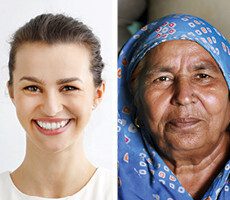- May 12, 2015
- By Chris Carroll
While economists traditionally deploy cold, hard numbers like gross national product and growth rates to compare welfare around the world, Carol Graham (below, inset) is trying a less conventional measurement: happiness.
Graham, a professor in the School of Public Policy and a senior fellow at the Brookings Institution, a Washington think tank, is a leader in a movement using subjective feelings of happiness to examine economic success and social mobility. For a recent study published in the journal World Development, she and her research partner, Milena Nikolova Ph.D. ’14, analyzed well-being metrics from the Gallup World Poll to assess factors that make people feel good—and how they vary across countries and income levels.
 Graham, who has published several books on the subject, focused on three subcategories of happiness. The first, hedonic well-being (from the same root word as “hedonism”), is a measure of how day-to-day existence feels. People in the poorest countries rated this kind of happiness most important.
Graham, who has published several books on the subject, focused on three subcategories of happiness. The first, hedonic well-being (from the same root word as “hedonism”), is a measure of how day-to-day existence feels. People in the poorest countries rated this kind of happiness most important.
In richer lands, people focused more on (and indeed, had had higher levels of) evaluative well-being, dealing with perceptions of overall success, rather than simply meeting basic needs. The third kind of happiness Graham tracked, called eudaimonic, is a measure of how fulfilling and meaningful people find their lives and roughly tracked income levels.
Her findings upend some stereotypes. For instance, conventional wisdom says Latin America is the capital of disparity between rich and poor, while the United States is the land of opportunity. Graham says, however, “We’ve found that the gaps in well-being between rich and poor are bigger in the United States than in Latin America.”
According to her research, the poor in the U.S. suffer greater stress and have less faith in the value of hard work than their low-income peers in Latin America, where rich and poor have roughly equal optimism about the possibility of getting ahead. In the United States, Graham says, only the wealthy buy into that.
The new reality appears to have arisen in recent years, she says. Although there’s not enough data to explain why, the change could be a result of some Latin American countries’ efforts to clean up their economies and take care of the poor, coupled with the U.S. financial crisis of 2008.
“We’ve always had this Horatio Alger, pull-yourself-up-by-your-bootstraps society and belief,” she says. “But it has obviously changed.”
Tags
Research